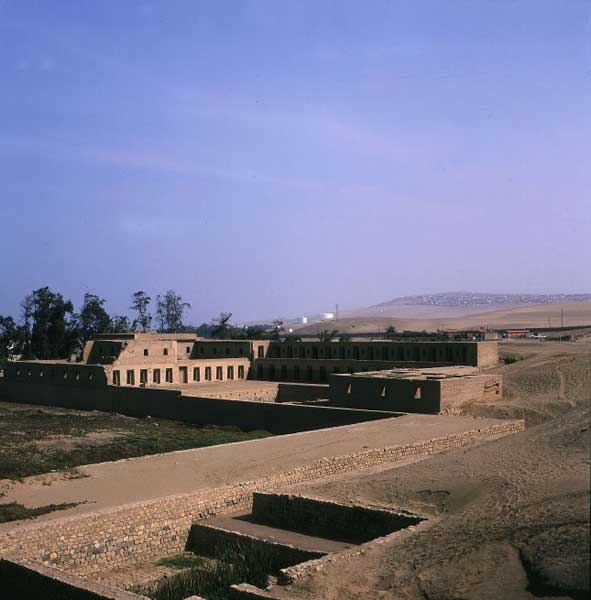Trail of the unexpected: Pachacamac
Machu Picchu may be off limits, but there are other ancient treasures in Peru

Anyone who cares to wander downstream from Aguas Calientes, the shambling town that serves Machu Picchu, will soon encounter startling evidence of the power of mud. The railway line that used to funnel beside the Urubamba Gorge was ripped up in a muddy deluge more than a decade ago, and the twisted steel of the track remains as evidence of the supremacy of nature – and the fragility of infrastructure in this part of Peru.
Not that any tourist can reach Aguas Calientes, or the sacred Inca citadel, right now. The climax of Peru's Sacred Valley is currently off-limits. Recent flooding and mudslides in the area left thousands stranded, and the Peruvian authorities are now assessing the damage caused to the train tracks that link the site with the nearby city of Cusco. Peru's National Chamber of Tourism estimates the cost of the closure at $500,000 (£330,000) per day.
The temporary closure of Peru's greatest wonder will mar many an itinerary. But traces of Peru's Inca and pre-Inca heritage can be found throughout the country. As the Pan-American highway heads south out of Lima, a small hill becomes visible to its left-hand side, rising out of the sandy rock that begins to dominate the landscape as the shanty towns of the capital thin out. Unremarkable from a distance, this was once the most breathtaking landmark on the Peruvian coast – an object of an important pilgrimage for many centuries, and now an important archaeological site.
This was a sacred city dedicated to Pachacamac. That might sound like a proprietary make of wet-weather gear for Peru's rainy season, but in fact Pachacamac was a powerful god who could predict the future. Pilgrims came from all over the Andean region to ask for advice.
The site was occupied for some 1,500 years by a succession of tribes, including the Wari, the Ychsma and, finally, the Incas. All left their mark on the place, building ever more elaborate temples to supersede those of their predecessors.
Until the buildings of the modern capital began to encroach, this was a remote, inaccessible place; for the modern visitor, it is the cliff-top location, overlooking the ocean, that impresses. Geography has always been important here: as well as being a strategic coastal site, Pachacamac is located in the valley of the Lurin River. This position helped to ensure food, in the form of fish and farm produce, for the gods. But for the pilgrims who had made the long, often arduous journey through mountains and valleys, it was not the natural landscape but the temples that would have made the strongest impression.
The most striking of these was the Painted Temple, built by the Yschma, who ruled the area from 1100 until the arrival of the Incas around 1430. According to archaeologist Gianella Pacheco, who is involved in preservation work on the temple, "when pilgrims got here, they would have thought they had reached the end of the world". She draws attention to traces of paint – red, yellow, blue and green – on the temple, and explains that these colours once covered the whole building. Outlines of human figures and corn are also still identifiable.
Further on is the Pilgrims' Plaza, a large, open area that was used as a meeting point. In front of it is the Painted Temple, but this was eclipsed, in size and location, by the Temple of the Sun. It was built on a hilltop by the Incas in the 15th century. It is this that is visible on the approach to the site from Lima. Built on six terraces, with a space on top where sacrifices could be made, it was covered in red plaster, traces of which are still visible.
Slightly away from the Temple is another Inca building, the Mamacona or Acllawasi, a convent-type establishment that housed women dedicated to the cult of sun worship. Now restored, it was built around two courtyards and contains a series of long galleries. Here, the women spent their time preparing food, textiles and other necessities for the temples.
After the Spanish conquest of Peru, Pachacamac ceased to be a place of religious pilgrimage. But in colonial times, wealthy families would come to the site for a day out, hoping to take home whatever artefacts they managed to find. It seems that there were plenty, since many of the ancient remains had been preserved by the arid climate of this coastal region. It is still possible to spot the odd human bone or clump of hair, half-buried in the sand. But even though treasure-hunting is no longer fashionable, Pachacamac has plenty to attract visitors in search of a day out of Peru's chaotic capital.
Travel essentials: Pachacamac
* Pachacamac (00 511 430 01 68) opens 9am-4.30pm daily except Monday, admission 12 pesos (£2.70).
* English-speaking guides cost 20 pesos (£4.45).
* A return taxi from the city centre: 80 pesos (£18).
* Mirabus (00 511 242 6699; mirabusperu.com ) runs half-day trips to Pachamac every Tuesday, departing at 10am from Parque Kennedy in Miraflores; 55 pesos (£12).
Join our commenting forum
Join thought-provoking conversations, follow other Independent readers and see their replies
Comments